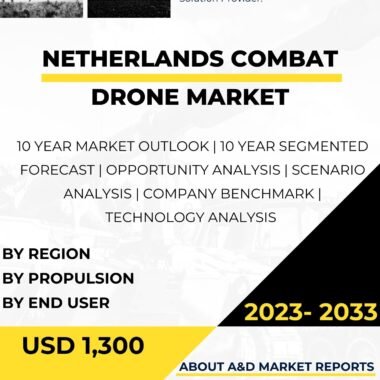Description
The combat drone market in Spain is a vital and rapidly evolving sector within the country’s defense industry. Combat drones, also known as Unmanned Aerial Vehicles (UAVs), have become increasingly important in modern warfare due to their versatility, intelligence-gathering capabilities, and ability to conduct precision strikes. Spain recognizes the strategic significance of combat drones in enhancing its military capabilities, and as a result, the market has witnessed significant growth in recent years.
Spain’s combat drone market is influenced by several factors, including changing security dynamics, advancements in drone technologies, defense policies, international collaborations, and the need to address a diverse range of security challenges.
The Spanish Armed Forces have been increasingly embracing combat drones as a key force multiplier. These unmanned aerial systems play a crucial role in enhancing Spain’s intelligence, surveillance, and reconnaissance (ISR) capabilities. By providing real-time situational awareness and intelligence-gathering capabilities, combat drones empower decision-makers with crucial information to make informed choices during military operations.
Moreover, combat drones offer the advantage of being able to access remote or hazardous environments without risking the lives of military personnel. This capability is particularly valuable in areas affected by natural disasters, humanitarian crises, or conflicts where traditional manned aircraft may face challenges in reaching or operating safely.
The Spanish defense industry plays a critical role in meeting the country’s combat drone requirements. Domestic companies, such as Indra Sistemas and Tecnobit, are actively involved in the development and production of combat drones for the Spanish Armed Forces. These companies leverage their expertise in aerospace, avionics, and unmanned systems to deliver state-of-the-art combat drones tailored to Spain’s defense needs.
International collaborations are also essential for Spain’s combat drone market. Many cutting-edge drone technologies are developed and manufactured by international companies with extensive experience in drone systems. Spain collaborates with these suppliers to acquire and integrate combat drones into its military operations. Joint ventures and technology transfer agreements enable the Spanish defense industry to contribute to the development of drone technologies while benefiting from international expertise.
The adoption and development of combat drones in Spain are driven by continuous technological advancements. The drone industry is characterized by rapid innovation, with improvements in sensor capabilities, communication systems, artificial intelligence, and endurance. Advancements in materials and miniaturization have also led to the development of smaller, more agile drones capable of operating in confined spaces or dense urban environments.
Spain’s commitment to participating in multinational military operations and peacekeeping missions further underscores the importance of combat drone capabilities. Combat drones enable Spain to contribute effectively to international efforts by providing ISR support and facilitating intelligence sharing with partner nations.
Budgetary considerations are a significant factor in the combat drone market. Like many countries, Spain faces budget constraints that can influence defense spending and investment in drone technologies. Balancing the allocation of resources between acquiring new combat drones and maintaining existing capabilities requires careful planning and prioritization.
Furthermore, the changing nature of security challenges and emerging threats influence Spain’s combat drone market. Combat drones are valuable assets in addressing asymmetric threats, such as terrorism and irregular warfare, where traditional military approaches may be less effective.
Spain’s commitment to international arms control agreements also influences its approach to the combat drone market. Ensuring compliance with export regulations and security standards is essential for facilitating international cooperation and maintaining regional stability.
The use of combat drones in Spain’s defense operations is not without challenges. While drone technologies provide significant advantages, they also raise concerns about ethical considerations, civilian casualties, and privacy issues. Spain, like other countries, must adhere to international legal frameworks governing the use of drones in armed conflicts and ensure the responsible and ethical use of this technology.
In conclusion, the combat drone market in Spain is a critical component of the country’s defense industry. Combat drones enhance Spain’s intelligence, surveillance, reconnaissance, and strike capabilities, providing valuable situational awareness and intelligence-gathering capabilities to decision-makers. The market encompasses a wide range of drone technologies, including advancements in sensors, communication systems, and artificial intelligence. Collaboration between domestic companies and international suppliers enables Spain to access cutting-edge drone technologies while contributing to their development. Technological advancements, international collaborations, budgetary considerations, and compliance with international arms control agreements are all factors influencing the Spanish combat drone market. As the Spanish Armed Forces continue to embrace combat drones to address diverse security challenges, the market will remain a key focus in enhancing Spain’s military capabilities and safeguarding national security.




